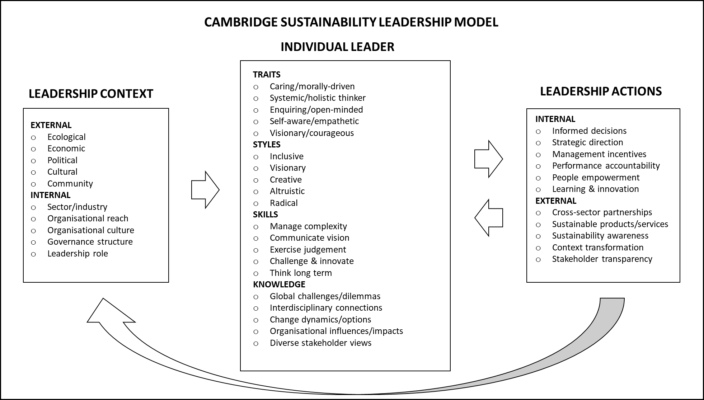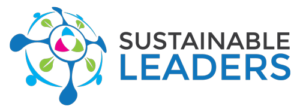Sustainable Leadership – what it is
Alongside values, managerial behaviours and Sustainability management are also affected by beliefs, character traits, styles and attitudes. The following article, from the “Sustainable Leadership in Europe” report, therefore analyses such factors in order to understand and point out how they can shape and define Sustainable Leadership.
“A Sustainable Leader must have a set of personal characters and managerial traits that enable him/her to lead with empathy inside a multitask-holder environment. A Sustainability leader is someone who inspires and supports action towards a better world.”
Alberto Pastore 2020
“The Sustainability Leadership Model” by Visser and Courtice[1], which was tested on a group of senior business leaders, will be taken into consideration while examining this topic. This model identifies three major components of Sustainability Leadership: the context wherein the leader operates; the characteristics of the specific leader; the actions of the leader. If understood as a whole, these components constitute a distinctive system which effectively responds to the Sustainability challenges. Naturally, each Sustainable Leader expresses his/her own peculiar combination of these elements.

Cambridge Sustainability Leadership Model / Source: Visser W., Courtice P. (2011), Sustainability Leadership: Linking Theory and Practice, 2011.
The authors describe the model components as follows:
- Leadership context:
“Context refers to the conditions or environment in which leaders operate, which have a direct or indirect bearing on their institutions and on their decision making. Referring to the context companies incorporate in their vision and mission what they are in business for, and then that gets enacted by continuous improvement processes that they carry out.”
- Individual leader characteristics: traits, styles, skills and knowledge:
“Individual Sustainability leaders are unlikely to embody all of the traits, styles, skills and knowledge in our model. Rather, they need to draw on what is appropriate or fitting to their own personality and circumstances, so as to be most effective in addressing Sustainability challenges. Furthermore, they will seek to develop these qualities in others, building teams that bring as many of the required elements to bear, and in effect enabling a form of distributed leadership.”
Figure 2.5-4 – Cambridge Individual Leader Characteristics of Sustainability Leadership Model
| Typical TRAITS of Sustainability Leaders | |
| Caring / morally driven | Care for the well-being of humanity and all other forms of life, as well as being guided by a moral compass. |
| Systemic / holistic thinker | The ability to appreciate the interconnectedness and interdependency of the whole system, at all levels, and to recognise how changes to parts of the system affect the whole |
| Enquiring / open-minded | Actively seeking new knowledge and diverse opinions, questioning received wisdom, including being willing to have one’s own opinions challenged |
| Self-aware / empathetic | High levels of emotional intelligence, (the ability to understand their own emotions and those of others), sincerity, personal humility and reflexiveness (the ability to see their own place in and influence on a situation) |
| Visionary / courageous | Bringing inspiration, creativity, optimism and courage to bear in the role, driven to produce results and possessing the ability to balance passion and idealism with ambition and pragmatism |
| Typical STYLES of Sustainability Leaders | |
| Inclusive | Collaborative and participative, building commitment through dialogue and consensus, democratic approaches, coaching, and a culture and structure that provides peer support, encouragement and recognises achievement |
| Visionary | Brings passion and charisma into the mix, focusing on challenging and transforming people’s perceptions and expectations, and motivating them to transcend narrower forms of self-interest |
| Creative | Playing the role of designer, architect, innovator, gamechanger and transformer of the system |
| Altruistic | Transcending self-interest and focusing on the collective or the good of the whole, which is often characterised as servant leadership |
| Radical | Highly visible leadership, characterised by taking risks, acting like a revolutionary, campaigner, crusader or activist and challenging of the status quo; often referred to as missionary leadership |
| Typical SKILLS of Sustainability Leaders
|
|
| Manage complexity | Analysing, synthesising, and translating complex issues, responding to risk, uncertainty and dilemmas, recognising and seizing opportunities and resolving problems or conflicts |
| Communicate vision | Sharing a vision and facilitating dialogue that inspires action and creates shared meaning (active listening, emotional intelligence, reflection) and creating conditions that encourage learning from experience |
| Exercise judgment | Making good and decisive decisions in a timely fashion, including prioritising, making difficult choices and handling dilemmas |
| Challenge and innovate | Imagining possible solutions/futures or alternatives, thinking outside the box, and bringing creativity into thinking and practice |
| Think long term | Envisioning and using strategic, long thinking and planning, seeing the whole, while not discounting the future |
| KNOWLEDGE for Sustainability leaders | |
| Global challenges and dilemmas | Social and ecological system pressures and the connections between these systems and political and economic forces |
| Interdisciplinary connectedness | The relevance and interconnectedness of the physical sciences, social sciences, technology, business and other disciplines |
| Change dynamics and options | How complex systems work and the range of options for promoting beneficial change in them, e.g. financial markets, policy options and trends, technology options, consumer behaviour and attitudes, organisational dynamics, change models and metrics |
| Organisational influences and impacts | An organisation’s full impact (footprint), finding and developing opportunities for value creation and new markets |
| Diverse stakeholder views | Different world views and belief systems, both within communities and across geographic, cultural and political divides, and how to incorporate these appropriately |
Source: Visser W., Courtice P. (2011), Sustainability Leadership: Linking Theory and Practice, 2011.
Available at SSRN: https://ssrn.com/abstract=1947221
- Courtice also provides an additional study on Traits and Style, identifying seven key traits and styles for the Sustainable Leader[2].
| 1. Systemic, interdisciplinary understanding The leaders who will help steer us towards a low carbon, more equitable world will need to deal with the depth and breadth of this challenge and make this a positive force within the organisations they lead.
2. Emotional intelligence and a caring attitude Leaders play a vital role in clarifying the values of the organisation, framing the relevant questions and helping to create a vision for a new future. It takes courage to challenge deeply held beliefs and ideological assumptions and it takes insight and skill to think systemically, build the adaptive capacity of an organisation, and inspire others to develop new strategies and learn new ways of operating.
3. Values orientation that shapes culture “There is personal, almost spiritual commitment that needs to be epitomised in someone who is going to be successful in this Sustainability space. So, a morality, a spirituality [which has] a great coupling with [having a] longer-term vision… Our credibility must come from the way that we behave and interact with the world. They epitomise interconnectedness. They understand community [in the sense of] communion with facets of the world around us.” Truett Tate (2010), Group Executive Director (Wholesale) for Lloyds Banking Group
4. A strong vision for making difference The real test, of course, is the actions these leaders take and the performance they deliver. One off actions and isolated Sustainability initiatives are no longer seen as a leadership position. What matters is how they run their businesses, whether they deliver tangible results and reward performance.
5. An inclusive style that engenders trust “Leaders actually lead through teams. The idea that you have a superstar leader is just nonsense. A great definition of leadership is about getting people to go where they wouldn’t have gone on their own. If they can get there on their own, then they don’t really need a leader. Equally, you can’t always be dragging them in the opposite direction to where they want to go.” Ian Cheshire (2010), CEO of Kingfisher
6. A willingness to innovate and be radical “Future capabilities will be very different, and will put a premium on lateral thinking and cross-functional, collaborative problem solving“. Jeffrey Swartz (2010), CEO of The Timberland Company.
7. A long-term perspective on impacts “Companies think much longer term than governments and good companies think much longer term than bad companies….” Neil Carson (2010), CEO of Johnson Matthey. |
[1] Visser W., Courtice P. (2011), Sustainability Leadership: Linking Theory and Practice, 2011. Available at SSRN: https://ssrn.com/abstract=1947221
[2] Courtice P., (2011), “The Challenge to business as usual”, in “A journey of a thousand miles. The state of Sustainability leadership”, Cambridege University.
Elements of Sustainable Leadership
| Sustainable Leadership elements | Concepts used in economics and business |
|---|---|
| Context | Recognising interdependence; complexity; ambiguity; interconnectedness; resource constraint; regulators; mega-trends |
| Consciousness | Mind-sets; worldviews; beliefs; mental models; attitudes |
| Continuity | Long-term horizon; courage; strength; common purpose; centredness; change processes |
| Connectedness | Serving needs of all stakeholders; both long- and short-term influencing; collaboration; trust; fairness; altruism; relatedness; needs instead of wants |
| Creativity | Innovation for sustainable shared value creation; sustainable business models; new value measurement models; flow |
| Collectiveness | Scale up for collective impact; embedding sustainability in business structure; sustainable consumption |
Source: Tideman S., Arts M., and Zandee D., (2013), “Sustainable Leadership: Towards a Workable Definition”, The Journal of Corporate Citizenship, N. 49



